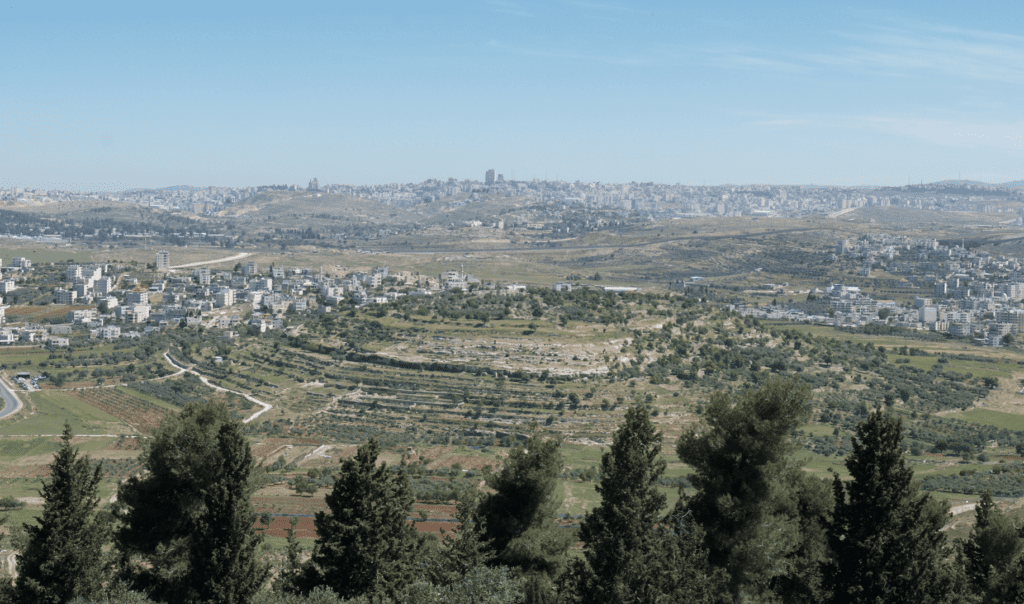Gibeon is a biblical city, identified with Tel El-Jib, some 4 kms southeast of Ramallah, covering an area of roughly 15.8 acres. The identification of El-Jib with Gibeon is fairly antiquated, and was first suggested by the Silesian (today, part of the northern Poland) explorer Franz Ferdinand von Triollo in 1666, though it is not known what he based his suggestion on. Later researchers accepted this identification for two main reasons: 1. The preservation of the name ‘Gibeon’ within the Arabic ‘El-Jib’. 2. The proximity of the site to Jerusalem, as Josephus had described it. In time, archaeological findings found at the site ascertained the identification. The city of Gibeon is mainly known for having been one of the five cities of the Gibeonites, a Hivite nation that scammed the Israelites and later entered servitude under them (Joshua 9:3-27). Later, Joshua halted the sun and the moon near that city (ibid. 10:12).


The Excavations at the Site
The site was excavated comprehensively during the years 1956-1960 by a joint expedition of the Jordanian Antiquities Authority and the Philadelphia University Museum, directed by the American archaeologist James Pritchard. In 1978 a small-scale salvage excavation was conducted at the site by archaeologist David Davis on behalf of the Staff Officer of Archaeology of the Civil Administration for Judea and Samaria.
The Site during the Bronze Age
The tel was first settled during the Early Bronze Age (3700-2500 BCE). Findings from this period include a storage building filled with storage jars, which may indicate the existence of an administrative system at the site. Unlike many other sites around the country, the site continued to be settled during the Intermediate Bronze Age (2500-2000 BCE), though like many other sites, was filled with graves. During the Middle Bronze Age (2000-1500 BCE), a city-state was probably built at the site, characterized by a rich material culture, including: Hyksosite scarabs, metal tools, jewelry and more. Later, several items from the Late Bronze Age (1500-1200 BCE) found at the site indicate that the site enjoyed international relations. Some of the items: Scarabs of Amenhotep II and Thutmose III, Cypriot jars which likely held perfumes, and more. However, the actual settlement layer of LB Gibeon has not been found yet, and likely existed in an area of the tel which has yet to be excavated. Evidence that there was, indeed, some form of settlement at Gibeon during this period is found in two magnificent tombs from this period, located on the western side of the tel.
The Site during the Iron Age
During the Iron Age I (1200-1000 BCE) the city wall was rebuilt, along with the construction of a water reservoir which was part of the city’s fortifications. Over it, another series of fortifications were constructed. To this period should likely be associated a staircase running down from the city to the spring at the base of the tel. The city continued to exist throughout the Iron Age II-III (the second half of the 10th century-586 BCE). According to the Shishak Inscription at Karnak, Gibeon was seized by him during his campaign in the Land of Israel. A destruction layer from that period has not been found, so it seems that Shishak did not destroy the city. During the 9th-6th centuries BCE the city flourished and a thriving wine industry developed, reflected in dozens of winepresses and several installations used for cooling wine found around the site. It’s possible that this industry was connected to the dozens of ‘LMLK’ handles found at the site. Several ‘private’ handles were also found, as well as a number of stamps, including a signet ring made of gold. A Scythian-style arrowhead indicates that the site was likely attacked by the Scythians that invaded the Land of Israel during the 7th century BCE. To this period should be associated a jar carved with the shape of a ‘Star of David’.
The Site from the Babylonian Period through the Roman Period
The city wasn’t destroyed during the Babylonian Destruction and continued to exist. One of the most significant findings from the 6th century BCE is a collection of dozens of jar handles that mention the name of the city, ‘GB’N’, along with names of families from the Tribe of Benjamin, such as: ‘Damla’, ‘Nera’ and ‘Gader’, as well as names of people who were part of those families, such as: ‘Amariah’, ‘Azariah’ and ‘Shvuel’. This finding ascertained the conception that El-Jib was to be identified with Gibeon. During the Persian period (mid-6th-mid 4th centuries BCE) the site dwindled in size. The site prospered once more during the 1st century BCE but was not fortified. Some of the wine cellars were renovated and turned into water reserves, and a new, large water reservoir was constructed.
biblical hiking map
Sources:
S. Ahituv, Handbook of Ancient Hebrew Inscriptions from the Period of the First Commonwealth and the Beginning of the Second Commonwealth (Hebrew, Philistine, Edomite, Moabite, Ammonite and the Bileam Inscription), Jerusalem 1993 [Hebrew]
D. Davis, ‘Gibeon’, Hadashot Arkheologiyot 69/71 (1979), p. 82 [Hebrew]
J. B. Pritchard, Gibeon: Where the Sun Stood Still, Princeton 1962

